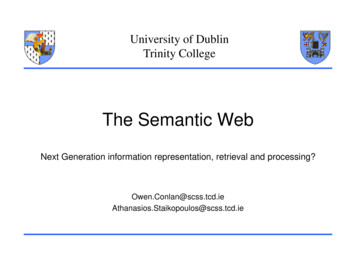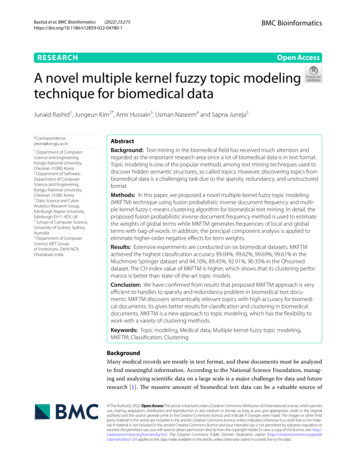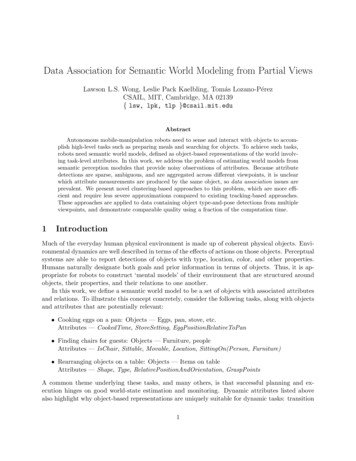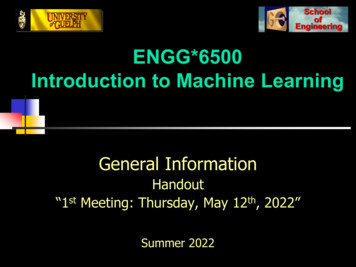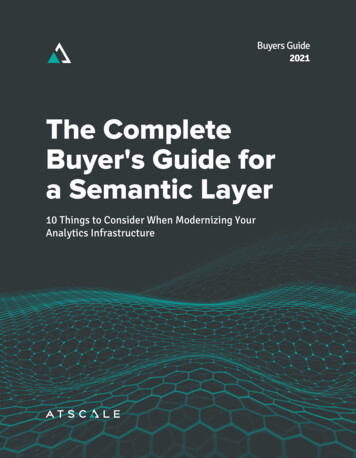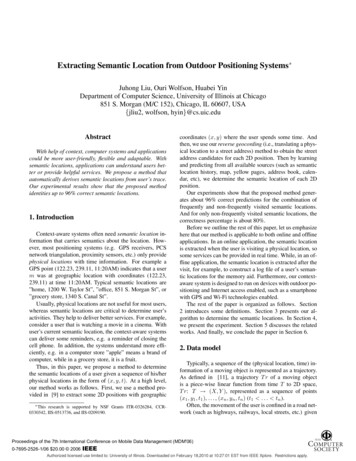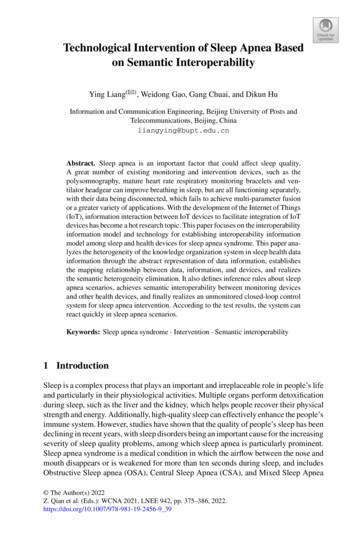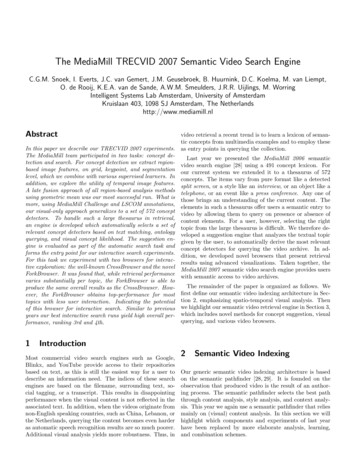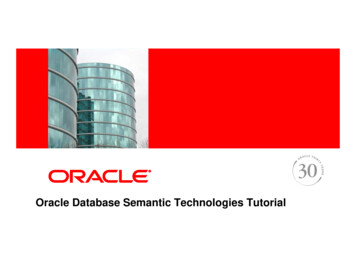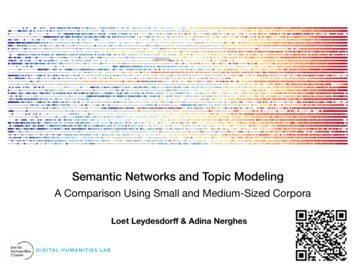
Transcription
Semantic Networks and Topic ModelingA Comparison Using Small and Medium-Sized CorporaLoet Leydesdorff & Adina NerghesD I G I TA L H U M A N I T I E S L A B
Networks of wordsContent networksSemantic NetworksCo-word mapsNetworks of conceptsMaps
Semantic networks and Topic ModelsTopic modelSemantic networkGoogle Trends for “topic model” (blue) and “semantic network” (red) on November 1, 2015.D I G I TA L H U M A N I T I E S L A B
Semantic networks Defined as: representational format [that would]permit the meanings' of words to be stored, sothat humanlike use of these meanings ispossible'' (Quillian, 1968, p. 216) The meaning of a word could be represented bythe set of its verbal associations Basic assumption: language (is) can be modeledas networks of words and the (lack of) relationsamong wordsD I G I TA L H U M A N I T I E S L A B
What makes semantic networks interesting? Correspond to a natural way of organizing information and the way humans think Semantic networks allow to model semantic relationships (Sowa, 1991) Investigate the meaning of texts by detecting the relationships between and amongwords and themes (Alexa, 1997; Carley, 1997a) Allow the analysis of words in their context (Honkela, Pulkki, & Kohonen, 1995) Expose semantic structures in document collections (Chen, Schuffels, & Orwig, 1996) Very flexible way of organizing data: you can easily extend the structure of semanticnetworks if needed You can easily convert almost any other data structure into semantic networks To represent knowledge or to support automated systems for reasoning aboutknowledge.D I G I TA L H U M A N I T I E S L A B
Semantic networks and the philosophy of science Hesse (1980)—following Quine (1960) argued that networks of cooccurrences and co-absences of words are shaped at theepistemic level and can thus reveal the evolution of the sciencesin considerable detail (Kuhn, 1984) The latent structures in the networks can be considered as theorganizing principles or the codes of the communication(Luhmann, 1990; Rasch, 2002) This “linguistic turn in the philosophy of science” makes thesciences amenable to measurement and sociological analysis(Leydesdorff, 2007, Rorty, 1992)D I G I TA L H U M A N I T I E S L A B
Software for semantic network generation and analysis Callon was the first to introduce semantic networks (co-word maps)on the research agenda of science and technology studies (STS) (Callon etti.exeal., 1983) However, the development of software for the mapping remained slowduring the 1980s (Leydesdorff, 1989) From the second half of the 1990s, many software packages becamefreely available Similar purpose —visualization of the latent structures in textual data(Lazarsfeld & Henry, 1968) — different results Two highly relevant parameter choices: similarity criteria clustering algorithmsD I G I TA L H U M A N I T I E S L A Bfulltext.exeWordjj.exe
Topic models A type of statistical model for discoveringthe abstract "topics" that occur in acollection of documents Frequently used text-mining tool fordiscovery of hidden semantic structuresin a text body The "topics" produced by topic modelingtechniques are clusters of similar wordsD I G I TA L H U M A N I T I E S L A B
Why topic models? To help to organize and offer insights for us to understandlarge collections of unstructured text bodies Used to detect instructive structures in data such asgenetic information, images, and networks Annotating documents according to these topics Using these annotations to organize, search andsummarize texts Applications in other fields such as bioinformaticsD I G I TA L H U M A N I T I E S L A B
Latent Dirichlet allocation (LDA) ‘‘LDA is a statistical model of language.’’ The most common topic model currently in use A generalization of probabilistic latent semantic analysis (PLSA) Developed by David Blei, Andrew Ng, and Michael I. Jordan in 2002 Introduces sparse Dirichlet prior distributions over document-topic and topic-worddistributions Assumption: documents cover a small number of topics and that topics often usea small number of words Other topic models are often extensions on LDA Currently more popular than semantic maps for the purpose of summarizingcorpora of textsD I G I TA L H U M A N I T I E S L A B
Tools for topic modelingMalletT-LAB PLUSTOMELDA AnalyzerLDAvis
A bottom-up perspective Large text corpora are beyond the human capacity to read andcomprehend Validity of the results with large text corpora remains a problem One can almost always provide an interpretation of groups of wordsex postAims: Taking a bottom-up perspective, we compare semantic networks andtopic models step-by-step Does topic modeling provide an alternative for semantic networks inresearch practices using moderately sized document collections?D I G I TA L H U M A N I T I E S L A B
Data The “Leiden Manifesto” (Hicks et al., 2015) Nature on April 23, 2015Guidelines for the use of metrics inresearch evaluation Translated into nine languages Units of analysis: 26 substantiveparagraphsLeiden Rankings (Waltman et al., 2012, at p. 2420) Google Scholar: "Leiden ranking" OR"Leiden rankings"Units of analysis: 687 documentsretrievedD I G I TA L H U M A N I T I E S L A BThe “Leiden Manifesto” 429 stop words list 550 unique words 75 occur more than twice Normalized word vectors by cosineTreshold cosine 0.2Leiden Rankings 429 stop words list noise words in languages other than English 56 words occur 10 times
University rankingFive clusters of 75 words in a cosine-normalized map (cosine 0.2) distinguishedby the algorithm of Blondel et al. (2008); Modularity Q 0.27. Kamada & Kawai(1989) used for the layout.D I G I TA L H U M A N I T I E S L A B
Nodes are colored according to the LDA model.(Words not covered by the LDA output are colored white.)Cramér’s V .311 (p .359)D I G I TA L H U M A N I T I E S L A B
“The Leiden Manifesto”: Semantic networks vs. LDA The topic model is significantly different in all respectsfrom the maps based on co-occurrences of words The results are incompatible with those of the co-wordmap The results of the topic model were significantly noncorrelated and not easy to interpretD I G I TA L H U M A N I T I E S L A B
Global university rankingFour clusters of 56 words in a cosine-normalized map (cosine 0.1) distinguished bythe algorithm of Blondel et al. (2008); modularity Q 0.36. Kamada & Kawai (1989)used for the layout.D I G I TA L H U M A N I T I E S L A B
Nodes are colored according to the LDA model.(Words not covered by the LDA output are colored white.)Cramér’s V .240; p .811D I G I TA L H U M A N I T I E S L A B
The Leiden Rankings: Semantic networks vs. LDA The two representations are significantly different. Even when using a larger set, the topic model stilldistinguished topics on the basis of considerationsother than semantics (e.g., statistical or linguisticcharacteristics).D I G I TA L H U M A N I T I E S L A B
Conclusion Topic modeling have become user-friendly and very popular in some disciplines, as well as inpolicy arenas We were not able to produce a topic model that outperformed the co-word maps The differences between the co-word maps and the topic models were statistically significant As topic models are further developed in order to handle “big data,” validation becomesincreasingly difficult However, the computer algorithm may find nuances and differences that are not obviouslymeaningful to a human interpreter (Chang et al., 2010; Jacobi et al., 2015, at p. 6). The robustness of LDA topic model results is unaffected by the lack of semantic and syntacticinformation (Mohr & Bogdanov, 2013), our results suggest differently in the case of small andmedium-sized samples Further steps: Hecking, T., & Leydesdorff, L. (2019). Can topic models be used in researchevaluations? Reproducibility, validity, and reliability when compared with semantic maps.Research Evaluation, 28(3), 263-272.D I G I TA L H U M A N I T I E S L A B
IDEAS WITH IMPACT:How connectivity shapes idea diffusionDirk Deichmann, Julie M. Birkholz, Adina Nerghes, ChristineMoser, Peter Groenewegen, Shenghui Wang
Context of science Goal of science: Produce (new) knowledge Increasingly done in co-authorship teams Disseminated through journal articles, conference proceedings,workshop presentations, demos, etc. These “dissemination events” are documented events of both a teamof co-authors and idea content Recognition of ideas through citationsD I G I TA L H U M A N I T I E S L A B
How to semantic and social networks relate tosuccessful idea diffusion? MOTIVATION: SOCIAL VS. CONTENT NETWORKCENTRALITY:Better understand the ideadiffusion process2JacobFrankEyal 3Not only focus on the socialnetwork position of the team ofinventors of an idea, but shed lighton the characteristics of the ideaitself1JasonLucyHenriPeter54Tom Disentangle the effects of a team’sposition in the social network fromeffects that are driven by the idea’sposition in the content tructureapplicationsocial5D I G I TA L H U M A N I T I E S L A Bteam4proctocol
Hypoteses CONTENT NETWORKS SOCIAL NETWORKSContent network centrality (Re-)combination of different concepts A central content network position is argued tofuel the idea diffusion process: Social network centrality Overlap – easier for others to identifythe focal idea as relevantSocial network centrality is argued to moderatethe effect of content network centrality on ideadiffusion A highly central team working on ahighly central idea reaches theoutskirts of the network Status of a central team helps toovercome challenges of an ideawhich is a (re-)combination of differentconceptsPopularity – get more attention fromthe communitySocial networkcentralityStatus and access to expertiseH2Content networkcentralityD I G I TA L H U M A N I T I E S L A BH1Idea diffusionsuccess
Data & Method Conference publication data Source: Semantic Web - subfield of Computer Science 31 conferences from 2006 - 2012 Controls: Number of title words Number of authors Scientific age (average) Prior citations (average) / prior publications(average) Conferences attended (average)2,492 conference items (proceedings, posters, demos)5,456 unique co-authorsDependent variable: Idea diffusion success Citation score after two yearsIndependent variable: Content network centralityVariablesModel 0.05)0.20***(0.04)-0.03(0.05)Number of title words Two-mode betweenness centrality (the number of times a nodeacts as a bridge along the shortest path between all other nodes)Number of authorsScientific age (average)Prior citations (average) Embeddedness in other ideasConferences attended (average)Content network centrality Moderating variable: Social network centralityIdea Diffusion SuccessModel 2Model 3Model 4-0.07(0.18)-0.03 .05)0.13***(0.03)Social network 8)-0.03 .05)0.13***(0.03)-0.00(0.03)-0.08(0.18)-0.02 .05)0.12***(0.03)0.02(0.03)0.18**(0.06)Content network centrality xSocial network centrality Two-mode betweenness centrality (the number of times a nodeacts as a bridge along the shortest path between all other nodes)Embeddedness in other co-authorship teamsD I G I TA L H U M A N I T I E S L A BVariance of constantVariance of residualLog likelihoodPublicationsConferencesModel 6-3464.372,09626
Results Ideas which are highly connected in thecontent network perform better and receivemore citationsA positive interaction between content andsocial network connectivityThe highest diffusion success can beattributed to publications with high contentconnectivity and high social connectivityIdeas which bridge different knowledgedomains in the content network will amasseven more citations when they aredeveloped by teams that are highlyconnected in the social network of coauthorship teamsD I G I TA L H U M A N I T I E S L A B1.21Idea diffusion success 0.80.6High social networkcentrality0.4Low social networkcentrality0.20Low content networkcentralityHigh content networkcentrality
Resources Leydesdorff, L. and Nerghes, A. (2017), Co‐wordmaps and topic modeling: A comparison usingsmall and medium‐sized corpora (N 1,000).Journal of the Association for Information Scienceand Technology, 68: 1024-1035. doi:10.1002/asi.23740 Ti.exe: http://www.leydesdorff.net/software/ti Fulltext.exe: http://www.leydesdorff.net/software/fulltext Pajek: actA D I N A . N E R G H E S @ D H . H U C . K N A W. N L@ADINANERGHES@DHLABHUCH T T P : / / W W W. D H L A B . N L
Correspond to a natural way of organizing information and the way humans think Semantic networks allow to model semantic relationships (Sowa, 1991) Investigate the meaning of texts by detecting the relationships between and among words and themes (Alexa, 1997; Carley, 1997a) Allow the analysis of words in their context (Honkela, Pulkki, & Kohonen, 1995)
